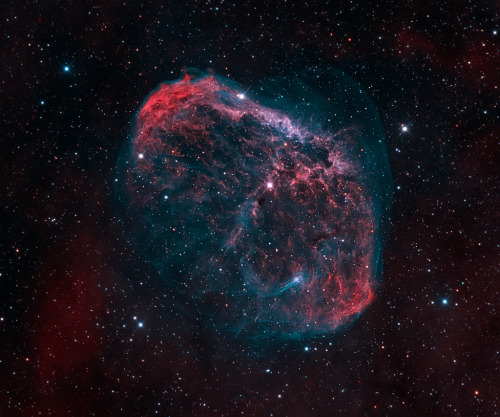NGC 6888 // Crescent Nebula, With Central Wolf-Rayet Star WR 136

NGC 6888 // Crescent Nebula, with central Wolf-Rayet Star WR 136
More Posts from Space-and-stuff-blog1 and Others

Horsehead Nebula // Barnard 33

Scheelite with Pink Apatite on Muscovite
Locality: Mt Xuebaoding, Pingwu Co., Mianyang Prefecture, Sichuan Province, China.

The Great Red Spot on Jupiter gets smaller by 580 miles per year



Messier 1 - The Crab Nebula
Potentially Humanity’s First Historically Observed Supernova
The Crab Nebula is the first astronomical object identified with a historical supernova explosion. Around in the year 1054, Chinese astronomers identified a large bright object that suddenly and mysteriously appeared in the sky. The explosion was so bright that it was even visible during the day time.
700 years later the super nova remnant faded in brightness as it expanded and was nearly forgotten. The Super Nova Remnant was rediscovered in 1758 ( officially re-recorded) by Charles Messier while he was creating a catalog of mysterious objects that looked like comets but were not.
We now know that the beautiful Crab Nebula is the magnificent result of the death of a star, which was unknown to Charles Messier and the Chinese Astronomers that discovered the Object. Now, thanks to space telescopes such as Hubble and Chandra, we can image the Nebula in great detail. The bottom left image is of a small region of the Crab Nebula. It shows “Rayleigh–Taylor instabilities in its intricate filamentary structure” and gives scientists a better understanding of the death of stars. The image to the bottom left shows combined visible light data from Hubble and x-ray data from Chandra.
Credit: NASA/Hubble/Chandra

In this new image from the NASA/ESA Hubble Space Telescope, a firestorm of star birth is lighting up one end of the diminutive galaxy LEDA 36252 — also known as Kiso 5649.
(via LEDA 36252, a cosmic tadpole | ESA/Hubble)
![Auroras On Jupiter [NASA/ESA Hubble]](https://64.media.tumblr.com/3c398bbe2f14958639a930dd0317b628/tumblr_o9mooygKxP1qd479ro1_500.gif)
Auroras on Jupiter [NASA/ESA Hubble]

Itty bitty Mercury transits the Sun. It was a terribly cloudy morning with really poor seeing, but managed to snap this.
-
 kawaiidesu reblogged this · 7 months ago
kawaiidesu reblogged this · 7 months ago -
 kawaiidesu liked this · 7 months ago
kawaiidesu liked this · 7 months ago -
 donutsandpancakes liked this · 8 months ago
donutsandpancakes liked this · 8 months ago -
 sydeshow19 reblogged this · 1 year ago
sydeshow19 reblogged this · 1 year ago -
 jeremylawson reblogged this · 1 year ago
jeremylawson reblogged this · 1 year ago -
 loraaababy reblogged this · 3 years ago
loraaababy reblogged this · 3 years ago -
 saecastrophe reblogged this · 4 years ago
saecastrophe reblogged this · 4 years ago -
 commsroom liked this · 4 years ago
commsroom liked this · 4 years ago -
 thomasbrisenio reblogged this · 4 years ago
thomasbrisenio reblogged this · 4 years ago -
 thomasbrisenio liked this · 4 years ago
thomasbrisenio liked this · 4 years ago -
 crycosmos reblogged this · 4 years ago
crycosmos reblogged this · 4 years ago -
 corpseomega-a liked this · 4 years ago
corpseomega-a liked this · 4 years ago -
 vietnam2005 liked this · 4 years ago
vietnam2005 liked this · 4 years ago -
 zenpunk-94 reblogged this · 4 years ago
zenpunk-94 reblogged this · 4 years ago -
 zenpunk-94 liked this · 4 years ago
zenpunk-94 liked this · 4 years ago -
 automaticdestinytrash reblogged this · 4 years ago
automaticdestinytrash reblogged this · 4 years ago -
 scorpvibessss liked this · 5 years ago
scorpvibessss liked this · 5 years ago -
 automaticdestinytrash reblogged this · 5 years ago
automaticdestinytrash reblogged this · 5 years ago -
 automaticdestinytrash reblogged this · 5 years ago
automaticdestinytrash reblogged this · 5 years ago -
 ourbillo liked this · 5 years ago
ourbillo liked this · 5 years ago -
 yakutyanochka liked this · 5 years ago
yakutyanochka liked this · 5 years ago -
 thestateofardadreaming reblogged this · 5 years ago
thestateofardadreaming reblogged this · 5 years ago -
 natsymac liked this · 5 years ago
natsymac liked this · 5 years ago -
 spoilingsponge liked this · 5 years ago
spoilingsponge liked this · 5 years ago -
 dube82 liked this · 5 years ago
dube82 liked this · 5 years ago -
 m-l-e-p liked this · 5 years ago
m-l-e-p liked this · 5 years ago -
 mister-dungus reblogged this · 5 years ago
mister-dungus reblogged this · 5 years ago -
 mister-dungus liked this · 5 years ago
mister-dungus liked this · 5 years ago -
 fictionalorfamous reblogged this · 5 years ago
fictionalorfamous reblogged this · 5 years ago -
 fictionalorfamous liked this · 5 years ago
fictionalorfamous liked this · 5 years ago -
 brightestofcentaurus reblogged this · 5 years ago
brightestofcentaurus reblogged this · 5 years ago -
 opsbts liked this · 5 years ago
opsbts liked this · 5 years ago -
 nib333 reblogged this · 5 years ago
nib333 reblogged this · 5 years ago
Just Space, math/science and nature. Sometimes other things unrelated may pop up.
119 posts



